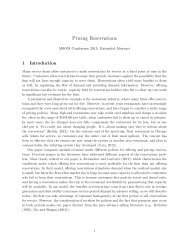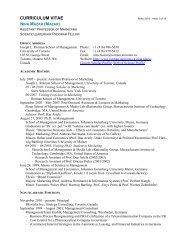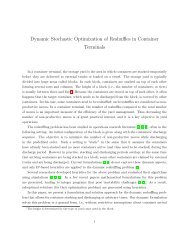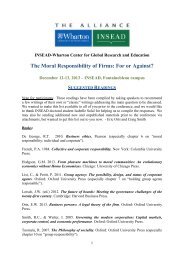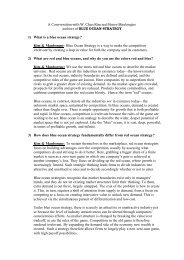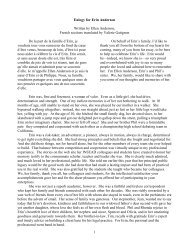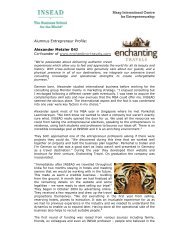RESPONSE - Insead
RESPONSE - Insead
RESPONSE - Insead
Create successful ePaper yourself
Turn your PDF publications into a flip-book with our unique Google optimized e-Paper software.
A Model of Social Consciousness and Socially Responsible Behavior Modelling Socially Responsible Behaviour<br />
knowledge transfer and translates into behaviour through deliberate action.<br />
Consciousness, on the other hand, is triggered primarily by external stimuli and<br />
produces behavioural outcomes without necessarily the intercession of will and<br />
deliberation. Therefore, one can expect awareness of the answers to questions like<br />
“what is CSR?” and “why is it important?” to raise via a classic classroom experience,<br />
but the development of social consciousness requires a lot more than the<br />
understanding of the answers to what, why and how questions. It requires changes in<br />
deeply rooted psychological mechanisms: emotional attitudes (care, trust, altruism,<br />
courage, etc.), tacit decisionmaking heuristics (what criteria do I instinctively apply<br />
when I have to make a difficult tradeoff), personal values (e.g. what matters most to<br />
me as a guiding principle in my life), etc.<br />
2. These type of deep personal changes are, in principle, achievable through the<br />
development of selfknowledge (understanding of one’s own traits, strengths and<br />
limitations) and of a profound commitment to think and feel differently in given<br />
situations or subject to specific stimuli. This is at the basis of clinical psychology and<br />
psychotherapy. But introspection also has its limits, since it is essentially a cognitive<br />
effort that is supposed to counter deeply rooted cognitive routines. It is cognition<br />
against cognition.<br />
3. These limitations might not apply, in theory, to meditative practices. In its traditional<br />
form, meditation is designed to reach a state of mental silence where cognitive activity<br />
is actually significantly reduced, with supposedly positive benefits for psychophysical<br />
health and personal growth (Neki, 1975). In that particular consciousness state, a<br />
metacognitive shift is typically described by practitioners where thoughts, feelings and<br />
actions, rather than occupying the person’s full attention, can be observed from a<br />
detached witnessing awareness from which they can be dealt with in a more efficient<br />
manner. When this state is routinized and integrated with normal mental and physical<br />
activity, not only a deep understanding of one’s own emotional traits, cognitive biases<br />
and subjective beliefs is apparently reachable, but significant and lasting changes to<br />
those traits might be possible (Rael Cahn and Polich, 2006)<br />
4. Evidence in high quality academic medical and neuroscience journals has been<br />
produced to show that (selected) meditation techniques influence specific<br />
psychological, physiological and pathological states (for a very recent review, see Rael<br />
Cahn and Polich, 2006). Perhaps the most interesting evidence relates to recent<br />
advances in our understanding of neuroplasticity, the capacity of the brain to redesign<br />
its own neural circuitry consequent to wilful attention and practice (Schwartz and<br />
Bailey, 2003). Lazar et al. (2005), for example, show neuroplasticity effects in long<br />
term Buddhist meditators. The mechanisms through which these changes occur are<br />
seem to relate to the activation of the limbic system, the same responsible for activities<br />
connected to the notion of “emotional intelligence”, as well as specific systems<br />
connected to higher consciousness functions (anterior cingulate cortex and dorsolateral<br />
prefrontal areas).<br />
5. In addition to the neuroplasticity effect, certain types of meditative practice appear to<br />
produce longterm effects on the practitioner’s psychoemotional stability (lower<br />
positive and negative mood swings), together with higher dispositions for positive<br />
emotions such as compassion and care. Aftanas and Golosheikin (2003), for example,<br />
show that experienced meditators (compared to novices) exhibit stronger “long<br />
distance” links between different areas of the brain connected with the production of<br />
positive emotions, even before they started meditating. This might be due to the<br />
development of specific capacities to produce positive emotional states and coherently<br />
positive behaviour. 15<br />
6. Finally, there are reasons to believe that meditation practice might influence the<br />
likelihood of socially responsible behaviour through its positive effects on occupational<br />
15 see Aftanas and Golocheikine (2000, 2001, 2003, 2005) for a series of studies on the neural<br />
correlates of a specific type of yoga meditation, similar to the one utilized in our experiments<br />
<strong>RESPONSE</strong>: understanding and responding to societal demands on corporate responsibility<br />
62



